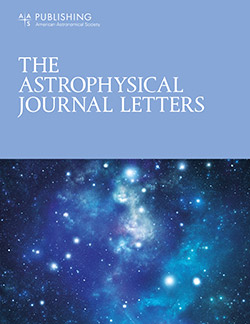极端潮汐剥离可能解释狮子座1号的超大质量黑洞:一个概念证明
IF 8.8
1区 物理与天体物理
Q1 ASTRONOMY & ASTROPHYSICS
引用次数: 0
摘要
最近的一项研究发现了动力学证据,证明在银河系最遥远的矮球状星系狮子座1号的中心存在一个超大质量黑洞,质量约为3 × 10 6 M⊙。这个黑洞的质量可与银河系的人马座A*相媲美,使该星系比标准的M•- M -百科关系高出两个数量级。从动力学的角度来看,我们研究了一种可能性,即狮子座1号的恒星系统最初的质量要大得多,因此更接近于这种关系。在银河系的病毒半径内,一两个近距离通道造成的极端潮汐破坏可能会带走它的大部分恒星质量。一个简单的分析模型表明,根据恒星速度色散的估计,狮子座1号的祖先可能在一次近心通道中经历了32%-57%的质量损失。如果在当前轨道重建允许的最小距离处出现中心,则质量损失百分比增加到66%-78%。详细的N -体模拟表明,最多两次通道的质量损失可以达到~ 90%,同样,周心距离与盖亚数据允许的最小值兼容。尽管狮子座I的性质存在很大的不确定性,但我们在因子<2内再现了它目前的位置和速度色散,以及1 kpc (~ 5 × 10 6 M⊙)内的最终恒星质量。最近的潮汐流沿着我们的视线指向利奥1号,这使得它很难被发现。这次极端潮汐破坏事件的证据可能以扩展潮汐流的形式出现在当前的盖亚数据中。本文章由计算机程序翻译,如有差异,请以英文原文为准。
Extreme Tidal Stripping May Explain the Overmassive Black Hole in Leo I: A Proof of Concept
Abstract A recent study found dynamical evidence of a supermassive black hole of ∼3 × 10 6 M ⊙ at the center of Leo I, the most distant dwarf spheroidal galaxy of the Milky Way. This black hole, comparable in mass to the Milky Way’s Sgr A*, places the system >2 orders of magnitude above the standard M • – M ⋆ relation. We investigate the possibility, from a dynamical standpoint, that Leo I’s stellar system was originally much more massive and, thus, closer to the relation. Extreme tidal disruption from one or two close passages within the Milky Way’s virial radius could have removed most of its stellar mass. A simple analytical model suggests that the progenitor of Leo I could have experienced a mass loss in the range 32%–57% from a single pericenter passage, depending on the stellar velocity dispersion estimate. This mass-loss percentage increases to the range 66%–78% if the pericenter occurs at the minimum distance allowed by current orbital reconstructions. Detailed N -body simulations show that the mass loss could reach ∼90% with up to two passages, again with pericenter distances compatible with the minimum value allowed by Gaia data. Despite very significant uncertainties in the properties of Leo I, we reproduce its current position and velocity dispersion, as well as the final stellar mass enclosed in 1 kpc (∼5 × 10 6 M ⊙ ) within a factor <2. The most recent tidal stream is directed along our line of sight toward Leo I, making it difficult to detect. Evidence from this extreme tidal disruption event could be present in current Gaia data in the form of extended tidal streams.
求助全文
通过发布文献求助,成功后即可免费获取论文全文。
去求助
来源期刊

Astrophysical Journal Letters
ASTRONOMY & ASTROPHYSICS-
CiteScore
14.10
自引率
6.30%
发文量
513
审稿时长
2-3 weeks
期刊介绍:
The Astrophysical Journal Letters (ApJL) is widely regarded as the foremost journal for swiftly disseminating groundbreaking astronomical research. It focuses on concise reports that highlight pivotal advancements in the field of astrophysics. By prioritizing timeliness and the generation of immediate interest among researchers, ApJL showcases articles featuring novel discoveries and critical findings that have a profound effect on the scientific community. Moreover, ApJL ensures that published articles are comprehensive in their scope, presenting context that can be readily comprehensible to scientists who may not possess expertise in the specific disciplines covered.
 求助内容:
求助内容: 应助结果提醒方式:
应助结果提醒方式:


